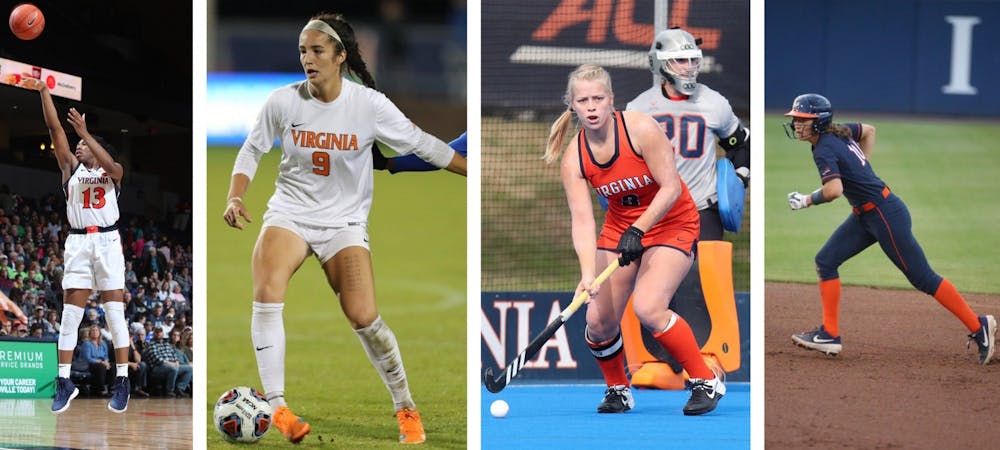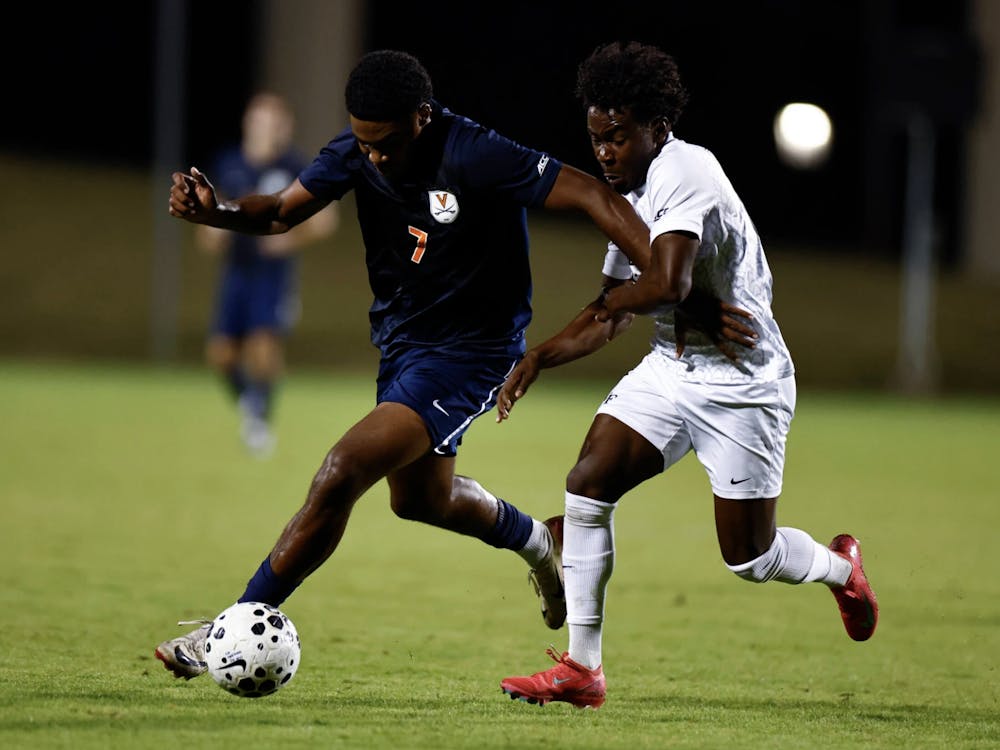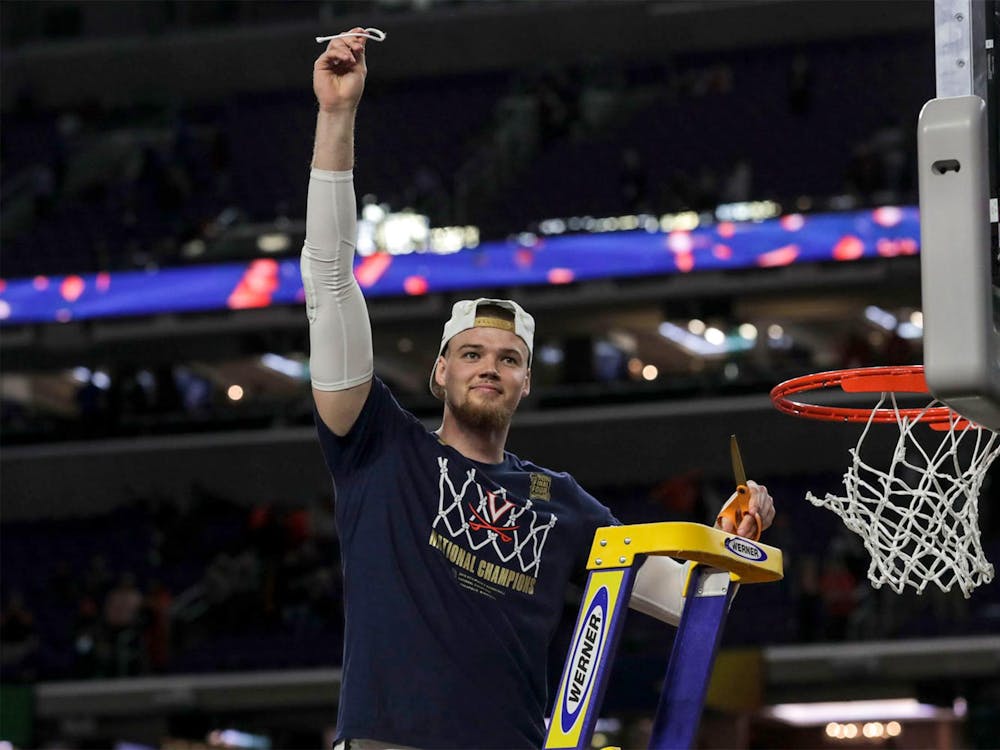Today, women make up more than half of the student body at the University and participate in 14 out of 27 varsity athletic teams. The athletics department is headed by Carla Williams, the first female African American athletics director at a Power 5 conference school. However, things weren’t always this way.
The University didn’t become fully coeducational until 1970, when 450 women enrolled in the College of Arts and Sciences as undergraduate students. Though no official female teams existed before gender integration, a few women still found a way to play sports.
Mary Slaughter — the daughter of Edward Slaughter, for whom Slaughter Recreation Center is named — joined the men’s tennis team in 1954 and became the first woman to earn a varsity letter at the University. She went on to win the Virginia State Women’s Championship in 1959, 1961 and 1963, before beginning a teaching career at the University of Illinois. In 1966, 12 years after Slaughter’s debut, Nursing student Mary Brundage joined the men’s swimming team.
Coeducation brought with it three guidelines for all women’s sports programs at the University — potential teams had to play for one year on the club level to prove that they could survive if elevated to varsity status, were obligated to have sufficient competition within both Virginia and the ACC and were required to have adequate facilities available for practice. Under these regulations, the women’s basketball, field hockey and tennis teams were established in the fall of 1971.
Title IX — signed into law by President Richard Nixon a year later, in June 1972 — would change women’s sports forever. While its overarching purpose was to require institutions recieving federal assistance to provide equal opportunites regardless of sex, the law ended up accelerating the expansion of many athletic programs nationwide. Universities could comply with the law in one of three ways — by maintaining a population of female student-athletes substantially proportional to the population of female students, demonstrating a history of adding sports for the underrepresented sex or proving that the university had accomodated all interests.
“What Title IX shows is that it wasn’t that women didn’t want to play — it’s that there were institutional barriers preventing them from actually participating in sport,” said Bonnie Hagerman, assistant professor of women, gender and sexuality. “Once you had Title IX, you had a lot of improvement in terms of access to those sports and you had recourse for it too.”
Despite the improvements Title IX was sure to bring, things didn’t change overnight. Schools were given until 1978 to make sure they were in full compliance with the law.
Months after Title IX had been passed, for example, the women’s club tennis team still had to rely on a volunteer — fourth-year Ted Putziger — to serve as their coach. But that was just the beginning of their problems.
“For a tennis match against Hollins this fall, Ted had to get some of his fraternity brothers to help with transportation since the University doesn’t provide any for us,” club member Lore Steinhauser said in an interview with The Cavalier Daily in 1972.
In addition, members had to figure out how to pay for entry fees to tournaments, equipment and uniforms using just $174 from Student Council, because as a non-varsity sport, they didn’t receive any financial support from the athletic department.
“The treatment the tennis club has received is only typical of the struggle girls’ sports have had since the beginnings of coeducation three years ago,” Barbara Hand wrote in a Cavalier Daily article, entitled “Girls’ Club Sports Compete Despite Discriminatory Policies,” in November 1972. “Instead of giving girls sports clubs special attention and help since coeducation is so new on the Grounds, the University’s attitude seems to be ‘let them develop the hard way.’”
Club tennis was promoted to varsity status in the spring of 1973, then finished its first official season with a 5-2 record.
Four years later, Margaret Groos became the first woman at the University to earn an athletic grant-in-aid — thanks in part to Title IX — when she joined the cross-country and track and field teams. In track, Groos set records in every distance event during her time at the University.
In 1981, women’s track and field won the University’s first non-NCAA women’s national championship. Later that year, the cross-country team became the first female team to win an NCAA women’s championship title. Five cross-country runners achieved All-American status that season as well. The team secured its second national championship win the next season.
The 1995-96 school year saw the promotion of women’s rowing to varsity status in order to comply with Title IX, as the addition equalized the number of men’s and women’s sports varsity teams at 12.
Since its inception, women’s rowing has become one of the most successful programs at the University. The team has won every ACC championship since 2010 and secured NCAA championships in both 2010 and 2012. Men’s rowing remains a club sport to date, and according to Hagerman, it’s unlikely that the team will ever attain varsity status because of Title IX rules.
At the 1996 Olympic Games in Atlanta, Dawn Staley and Melanie Valerio made University history when they became the first female alumnae to win gold medals. The two competed as members of the USA basketball and swimming teams, respectively. Today, Staley holds the record for the most individual Olympic medals and the record for most individual gold medals of any University alumni.
Four years later, in 2000, William C. Eacho, Jr. donated $1.4 million towards creating a scholarship endowment for a women’s golf program. Almost a year later, University Athletics Director Craig Littlepage announced that the team would begin competition in the 2003-04 academic year.
However, the creation of a women’s golf team did not come without controversy. In 2001, the Virginia 2020 Strategic Task Force for the Department of Athletics released a report recommending that the University adopt a tiering system for its sports programs.
The report also suggested eliminating the men’s indoor track and field team and replacing it with women’s golf to combat the department’s growing budget deficit and move the University closer to being in compliance with Title IX’s proportionality requirement, which mandates that women’s representation in athletics be proportional to its representation in a university’s student body. If not dropped, men’s indoor track and field would be a part of the lowest tier and would in turn receive the least amount of funding. Several University athletes and coaches expressed concern over the proposal and it was rejected by two committees of the University Board of Visitors later that year.
Hagerman explained the refusal to cut men’s sports largely in terms of Title IX.
“When you delete programs, even if you’re deleting programs for men and women, it still hurts women more than it hurts men because you have so few programs for women in the first place,” Hagerman said.
Despite the contention, women’s golf was still added as a varsity sport. The team debuted with a 302-334 win against Richmond in 2003, making it the 13th women’s program to be established at the University.
Another women’s sport wouldn’t be added for another 14 years. Thanks to a donor gift, club squash — both the men’s and women’s teams — was promoted to varsity status in 2017, making it the 14th and final women’s sport to be added.
Since the start of coeducation, female students and alumni have competed in nine different Olympic Games. They account for 10 gold medals, are responsible for seven NCAA championships — compared to five gold medals and 20 NCAA championships achieved by male athletes — and have received numerous other awards. In other words, things certainly have changed in the last 50 years.







